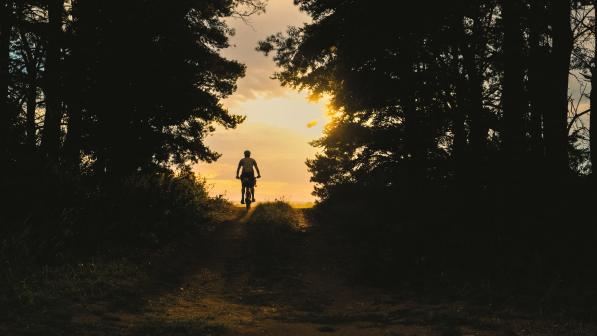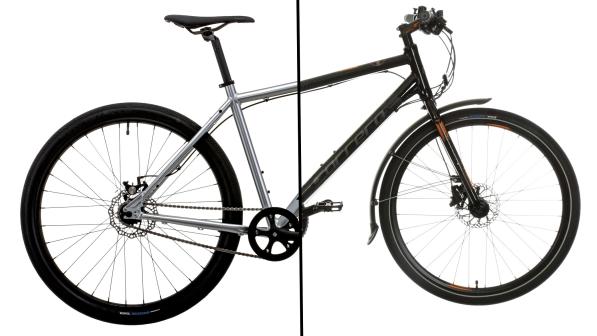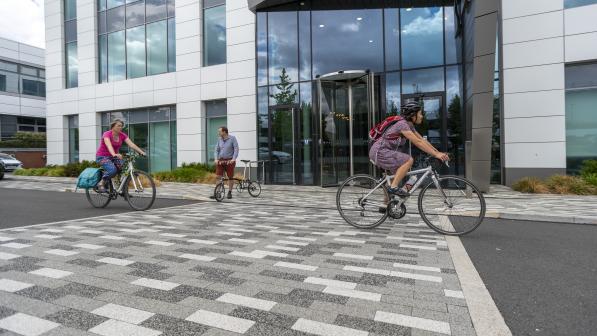An A-Z of cycle commuting

ASSISTANCE Electrical assistance, that is. If your journey to work is too hilly or too far for you to cycle comfortably, or if you want to arrive without breaking a sweat, an electric bike could be the answer – it’s like cycling with a constant tailwind. Expect to pay from £1,500 for a decent model.
BAG Panniers, rack-top bags and saddlebags beat backpacks for luggage, especially for heavier loads and longer journeys. With the weight on your bike instead of your shoulders, you’ll sweat less and you won’t get a sore backside and numb or tingling hands.
CLOTHING Lycra makes sense for a fast ride on a road bike. For a trip into town? Not so much. Why not choose or change your bike to suit your clothing rather than vice-versa? A Dutch-style upright roadster with mudguards and a chainguard can be ridden in a suit or a dress.
DOGS Some are friendly; others want to chase and bite you. Long leads can also be a hazard on shared-use paths. If an angry dog is off its lead, try canine psychology first: point at it and shout “Stay!” in a commanding voice. No luck? Can’t outpace it? Dismount, put the bike between you and the dog, then try again.
EXHAUST FUMES Unless you have an existing respiratory problem, a face mask can be more hindrance than help. Urban air quality is typically worse inside cars than at the kerbside as the pollution doesn’t disperse. The best way to avoid inhaling fumes, however, is to choose routes where the heavy traffic isn’t.
FOOD Moderate cycling burns around 300 calories an hour, so a half hour each way commute means you can have a cake with your morning coffee and not put on weight. No special diet is required for commuting, although longer-distance commuters will need to eat more.
GEARS It doesn’t matter how many gears your bike has as long as they’re low enough for your commute. Singlespeeds and three-speed hub gears are fine in flatter cities, while derailleur setups help with hills. If you find climbing hard, get a bike whose biggest sprocket has more teeth than the smallest chainring.

HELMET The importance of helmets for utility cycling is often exaggerated. The safest country to ride a bike is the Netherlands, where no one wears a helmet. If you choose to use one, bear in mind that cheap helmets pass the same safety standards as expensive ones. Just make sure it’s comfortable and wear it correctly.
ILLEGAL Many road users break the law – driving above the speed limit, going through a traffic light as it turns red and so on. Cyclists who break the law put themselves at risk and undermine attitudes towards cycling. Don’t fall into the ‘everyone does it’ fallacy. Cycle legally, confidently and courteously.
JUNCTIONS Traffic interactions at junctions should be straightforward, if only everyone observed rights of way and showed common sense. But some road users don’t even seem to look. If right turns and roundabouts make you nervous, sign up for some Bikeability cycle training; it isn’t just for children.
KA-CHING Cycle commuting saves you money. If you swap your shorter journeys from car to bike, you can save hundreds of pounds a year on fuel alone. Factor in the fixed costs and the savings are much higher – potentially thousands. You can also save hundreds by switching from public transport to cycling.
LOCK Every year, around 100,000 bicycles are reported stolen in England and Wales alone. Get a good lock. The police recommend spending at least 10% of the value of your bike on security for it. Buy a D-lock or big chain rated Sold Secure Gold or Diamond. In high-theft areas, use both – or park your bike indoors.
MUDGUARDS The essential transport cycling accessory. Full-length guards that fix to the frame and fork are best. They keep you clean and dry on wet roads, and they keep your bike cleaner too so it needs less maintenance. Even if you wear bike gear, mudguards prevent you having to pull on soggy kit for the commute home.
N+1 This is the formula for working out how many bikes to own, where N is the number that you currently own. There’s always room for another bike! Bikes aren’t like cars; they’re more like shoes, with different kinds being more or less suitable for different tasks.

OIL A bicycle chain needs oiling: roughly monthly during summertime, perhaps weekly in winter, and after any ride in very heavy rain. Pedal the cranks backward by hand and apply oil to each link where the chain emerges from the bottom of the derailleur. Use newspaper to catch drips and a rag to wipe off excess oil.
PUNCTURES Flat tyres are rare. You can make them rarer by using tougher tyres and keeping them properly inflated. If you do puncture, it’s only a five-minute delay so long as: you are carrying a spare innertube, two tyre levers and a pump; and you’ve practised fitting a spare tube at home.
QUICKER Bicycles are faster than cars in busy towns and cities because they can keep moving while cars sit in queues. Don’t worry about your top speed on a bike. Plot your route so that it avoids too many traffic lights and gridlocked roads, so you can keep rolling along. Use back streets and cycle tracks. They’re more pleasant, too.
ROAD TAX “You cyclists don’t even pay road tax,” the angry driver says. No one does. There’s no such thing. Vehicle Excise Duty is an emissions tax that doesn’t directly pay for the roads. Bicycles are zero emission vehicles so would pay nothing, even if it were levied on them.
SADDLE There is no one perfect saddle. But there is a saddle that you will find comfortable for the cycling that you do. It will carry your bodyweight on your sit bones rather than soft tissue, and it will need to be set at the right angle and right height. Feeling sore? Try a wider saddle, perhaps with a cutout, set dead level.
TAKE THE LANE Hugging the kerb may feel safer but it isn’t. Whenever there isn’t room for you to be overtaken safely, dissuade drivers from doing so by riding in the centre of your lane. You are the traffic! Approaching a pinch-point, a blind corner, give way markings or traffic lights? Take the lane.
UNDERWEAR Padded Lycra shorts are designed to be worn next to the skin, without underwear, to prevent chafing. Utility trips seldom require Lycra shorts; everyday clothes and normal underwear are usually fine. But if you want some extra cushioning, padded underwear is available for men and women.

VISIBILITY Any bike on a public road between dusk and dawn must have a white front light, a red rear light, a red rear reflector and amber pedal reflectors. Reflective details on your clothing or the bike help you stand out at night, while a brightly coloured jacket or jersey improves visibility during the day.
WATERPROOFS Don’t be misled by the words ‘showerproof’ or ‘water repellent’, which are secret code for ‘leaks like a tea bag’. For actual British rain, you need clothing made from waterproof fabric with taped or welded seams. Even then, you’ll need to cycle slower too to avoid overheating and getting damp with sweat instead.
XXL Cycle commuting isn’t just for skinny people. It’s ideal low-impact exercise for anyone with a high body mass index, as your weight is carried by the bike. Get a sturdy hybrid with wide tyres and low gears – and cycle at your pace, keeping distances short to begin with. If you want to get fitter, cycling will help.
YOUTH Cycling keeps you young. According to the British Medical Association, regular cyclists enjoy a level of fitness equivalent to someone 10 years younger, and live an average of two years longer than sedentary individuals.
ZEBRA CROSSING Pedestrians have right of way here. Give them time. The same goes for shared-use cycle tracks and bridleways, where cyclists are obliged to give way to walkers. Slow down, ping your bell and pass with plenty of room.
Find out more
If you’re thinking about cycling to work, we have loads of advice on getting started. We also have plenty on staying safe while cycling.
Cycle magazine
Every two months Cycling UK members receive Cycle magazine, filled with interesting and informative articles, news and reviews for all cyclists.
Members can read the magazine in full online; non-members can read selected highlights.


